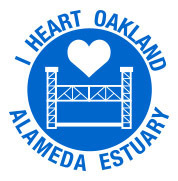Dolphins, Porpoises, and Whales in Oakland, Alameda & San Francisco Bay

Photo Credit Gray whale: J. Imperial/TMMC, under NOAA permit #20632
I Heart ♥️ connected with The Marine Mammal Center’s team that studies Whales, Dolphins and Porpoises off the Oakland and Alameda shores.
Bill Keener is a research biologist in the Cetacean Conservation Biology program at The Marine Mammal Center, the world's largest marine mammal hospital. The Cetacean Conservation Biology team monitors the living wild populations of cetaceans – whales, dolphins, and porpoises – in the San Francisco Bay area. Keener’s work focuses on the four species of cetaceans in San Francisco Bay: the humpback whale, gray whale, bottlenose dolphin, and the harbor porpoise.
What cetaceans have you researched off the shores of Oakland and Alameda?
Humpback whales
Humpback whales are the largest, at 50 to 60 feet long. When they come up to breathe, they have a big spout, a huge puff of steam that goes a dozen feet into the air. They have a little dorsal fin on their back, a small triangular fin that sticks up as they roll over.
The deepest area in the bay is under the Golden Gate Bridge, where it's 300 feet deep. As you go south of the Bay Bridge, it gets shallower, so not many large whales tend to go past this point. But in June of 2019, a humpback named Allie entered and stayed close to the shore in Alameda for a month before leaving.
Gray whales
Gray whales are 40 or 50 feet long. They have a spout that goes up about 10 feet and a ridge of little knuckles that roll over on their back. They don't have a distinctive dorsal fin like the humpback.
In 2023, gray whales were hanging out in the shallow, muddy areas of Oakland, Alameda, and Berkeley. Gray whales are usually on their way to Alaska to their feeding grounds. These waters are shallow, muddy areas, and I think the areas off Alameda, Oakland, and Berkeley remind them of that kind of habitat. Gray whales feed on crustaceans and little worms in the mud on the sea floor. They are getting some of that food off the shores of Oakland, Alameda, and Berkeley.
Bottlenose dolphins
Bottlenose Dolphins are about 10 feet long. They are very social, and usually travel in small groups. However, in 2016 a lone bottlenose dolphin showed up off the shores of Alameda and Oakland and was given the name Kaimi by the O Kalani Canoe Club. Later Kaimi was joined by an adult, a larger dolphin we named Arc, who I suspect was its mother. By early 2019, Kaimi had left the area and met up with other dolphins in Pacifica.
Humpback whales
Humpback whales are the largest, at 50 to 60 feet long. When they come up to breathe, they have a big spout, a huge puff of steam that goes a dozen feet into the air. They have a little dorsal fin on their back, a small triangular fin that sticks up as they roll over.
The deepest area in the bay is under the Golden Gate Bridge, where it's 300 feet deep. As you go south of the Bay Bridge, it gets shallower, so not many large whales tend to go past this point. But in June of 2019, a humpback named Allie entered and stayed close to the shore in Alameda for a month before leaving.
Gray whales
Gray whales are 40 or 50 feet long. They have a spout that goes up about 10 feet and a ridge of little knuckles that roll over on their back. They don't have a distinctive dorsal fin like the humpback.
In 2023, gray whales were hanging out in the shallow, muddy areas of Oakland, Alameda, and Berkeley. Gray whales are usually on their way to Alaska to their feeding grounds. These waters are shallow, muddy areas, and I think the areas off Alameda, Oakland, and Berkeley remind them of that kind of habitat. Gray whales feed on crustaceans and little worms in the mud on the sea floor. They are getting some of that food off the shores of Oakland, Alameda, and Berkeley.
Bottlenose dolphins
Bottlenose Dolphins are about 10 feet long. They are very social, and usually travel in small groups. However, in 2016 a lone bottlenose dolphin showed up off the shores of Alameda and Oakland and was given the name Kaimi by the O Kalani Canoe Club. Later Kaimi was joined by an adult, a larger dolphin we named Arc, who I suspect was its mother. By early 2019, Kaimi had left the area and met up with other dolphins in Pacifica.

Bottlenose dolphin Kaimi at the bell buoy. Bottlenose dolphin: B. Keener/TMMC, under NOAA permit #20386.
Harbor porpoises
Harbor porpoises are five to six feet long. They only come up to the surface for a second. There's a small triangular, dorsal fin, and no spout. Harbor porpoises were gone from the bay for about 60 years, from World War II until 2008, and now they are here every day.
Let's look at the history of the East Bay. There are aboriginal indigenous middens called shellmounds where the ancient peoples would throw the shells or refuse of what they'd been eating. If you look at the mounds created over thousands of years, well before Europeans came to these shores, there were many sea otters and porpoises in San Francisco Bay.
Later, sea otters were hunted out of the bay. Harbor porpoises were also driven away but are now back where they belong historically.
Why do you think cetaceans are now in the San Francisco Bay?
When I started volunteering at the Marine Mammal Center in 1977, there were no cetaceans in the bay. That has dramatically changed in the last 10 to 15 years, and now we have whales, dolphins, and porpoises here.
Each species of cetacean has its conservation status and its own story. A lot of it has to do with food. Where you find good food, you'll find wild animals.
In World War II, a submerged net stretched across the entire bay, keeping whales, porpoises, and everything out. Back then, the bay was contaminated, with sewage and industrial pollution going unchecked, and very busy with ship traffic. It took decades of work by a lot of people, along with the Clean Water Act, to clean up the bay.
Humpbacks were hunted until the 60s, with the last whaling station in the United States in San Francisco Bay. They had catcher boats out of Richmond and would harpoon whales outside San Francisco, drag them back, and process them as pet food. Stopping hunting allowed humpback whales to recover, and since 2016, they've been in the bay feeding on anchovy.
Another reason whales like coming into the bay is the calm water, compared to the ocean, the outer coast. The waters in the South Bay are protected, and that creates shelter for the animals.
The bottlenose dolphin’s story is a bit different. It could be because of climate change that they are coming up from Southern California.
While the conditions and details vary for each cetacean, one thing they have in common is a cleaner San Francisco Bay, and more fish that attract them here.
Harbor porpoises are five to six feet long. They only come up to the surface for a second. There's a small triangular, dorsal fin, and no spout. Harbor porpoises were gone from the bay for about 60 years, from World War II until 2008, and now they are here every day.
Let's look at the history of the East Bay. There are aboriginal indigenous middens called shellmounds where the ancient peoples would throw the shells or refuse of what they'd been eating. If you look at the mounds created over thousands of years, well before Europeans came to these shores, there were many sea otters and porpoises in San Francisco Bay.
Later, sea otters were hunted out of the bay. Harbor porpoises were also driven away but are now back where they belong historically.
Why do you think cetaceans are now in the San Francisco Bay?
When I started volunteering at the Marine Mammal Center in 1977, there were no cetaceans in the bay. That has dramatically changed in the last 10 to 15 years, and now we have whales, dolphins, and porpoises here.
Each species of cetacean has its conservation status and its own story. A lot of it has to do with food. Where you find good food, you'll find wild animals.
In World War II, a submerged net stretched across the entire bay, keeping whales, porpoises, and everything out. Back then, the bay was contaminated, with sewage and industrial pollution going unchecked, and very busy with ship traffic. It took decades of work by a lot of people, along with the Clean Water Act, to clean up the bay.
Humpbacks were hunted until the 60s, with the last whaling station in the United States in San Francisco Bay. They had catcher boats out of Richmond and would harpoon whales outside San Francisco, drag them back, and process them as pet food. Stopping hunting allowed humpback whales to recover, and since 2016, they've been in the bay feeding on anchovy.
Another reason whales like coming into the bay is the calm water, compared to the ocean, the outer coast. The waters in the South Bay are protected, and that creates shelter for the animals.
The bottlenose dolphin’s story is a bit different. It could be because of climate change that they are coming up from Southern California.
While the conditions and details vary for each cetacean, one thing they have in common is a cleaner San Francisco Bay, and more fish that attract them here.

Harbor porpoises: B. Keener/TMMC, under NOAA permit #20386.
What do bottlenose dolphins and harbor porpoises eat?
Porpoises are small, and they have tiny teeth, so they don't even chew their food. They grab the fish and swallow them whole. They're looking for small fish like anchovy and maybe herring.
Bottlenose dolphins are larger and have bigger teeth. They can chew larger fish, and they look for all kinds of fish, such as striped bass. Some of the same fish the fishermen are going after, the dolphins go after.
How do cetaceans sleep?
Cetacean sleep is interesting and different from that of land mammals, including humans. They've developed a way of keeping part of their brain awake while sleeping. What scientists have observed while dolphins sleep is that they'll go in a big slow circle and move up and down, breathing while being half asleep.
It is a type of sleep where only half of the brain can sleep at a time. They're always awake with half their brain, sleeping with the other half. That's because they are conscious breathers, unlike human beings.
If we relax, are unconscious, or sleep, we still breathe. That is not true for cetaceans. For them, breathing is a conscious activity. If they are unconscious, they stop breathing, and that will kill them.
Porpoises are small, and they have tiny teeth, so they don't even chew their food. They grab the fish and swallow them whole. They're looking for small fish like anchovy and maybe herring.
Bottlenose dolphins are larger and have bigger teeth. They can chew larger fish, and they look for all kinds of fish, such as striped bass. Some of the same fish the fishermen are going after, the dolphins go after.
How do cetaceans sleep?
Cetacean sleep is interesting and different from that of land mammals, including humans. They've developed a way of keeping part of their brain awake while sleeping. What scientists have observed while dolphins sleep is that they'll go in a big slow circle and move up and down, breathing while being half asleep.
It is a type of sleep where only half of the brain can sleep at a time. They're always awake with half their brain, sleeping with the other half. That's because they are conscious breathers, unlike human beings.
If we relax, are unconscious, or sleep, we still breathe. That is not true for cetaceans. For them, breathing is a conscious activity. If they are unconscious, they stop breathing, and that will kill them.

Humpback whale Allie in Alameda: B. Keener/TMMC, under NOAA permit #21678.
Can you speak to their intelligence and how they interact with each other, live, and thrive?
One thing we know about how dolphins and whales have evolved in the ocean is that they need a big brain to survive. This is partly because they are navigating in a vast wilderness that looks uniform, and they need to be able to find their way.
Dolphins and porpoises are different from whales in that they have biosonar or echolocation. They send out a pulse of sound into the water. That pulse is reflected off a fish, or a rock, or one of their fellow dolphins, forming a three-dimensional picture in their brain. They construct a sonic picture from the sound of their world. They're very acoustic animals. They live by their ears, while we often manage by looking at things.
Dolphin brains are as large as human brains in terms of raw size. They are, in a sense, an alien species, in that we don't understand the world from their point of view.
They certainly have complex social societies, and in fact, researchers talk about whale culture and how different whales can learn new things and pass knowledge to their young. This includes things like different hunting techniques. Bottlenose dolphins have even used tools in the ocean for hunting.
What can we do to protect cetaceans?
I want to encourage people to keep their eyes out for dolphins, porpoises, and whales and report them through the Marine Mammal Center's website when they see them. If you see an animal in distress or entangled, report it. That information goes directly to our team, and we act on it. We can get out there on a boat.
What can Oaklanders do to support cetaceans?
The San Francisco Bay is a working bay; it is busy. One of the things that the Marine Mammal Center is very concerned about is the risk of ship strikes on whales. There's a lot of commercial marine traffic in the San Francisco Bay. We are working with the Ports of Oakland and San Francisco and the Coast Guard to create best practices for large ships to slow down and avoid any chance of striking, injuring, and killing a whale.
When they ingest plastic, that impacts them directly. It's important to clean the bay so no toxins, foreign pollutants, and floating plastics are in their realm or habitat.
To learn more about the amazing San Francisco Bay cetaceans visit The Marine Mammal Center in Sausalito, Ca.
One thing we know about how dolphins and whales have evolved in the ocean is that they need a big brain to survive. This is partly because they are navigating in a vast wilderness that looks uniform, and they need to be able to find their way.
Dolphins and porpoises are different from whales in that they have biosonar or echolocation. They send out a pulse of sound into the water. That pulse is reflected off a fish, or a rock, or one of their fellow dolphins, forming a three-dimensional picture in their brain. They construct a sonic picture from the sound of their world. They're very acoustic animals. They live by their ears, while we often manage by looking at things.
Dolphin brains are as large as human brains in terms of raw size. They are, in a sense, an alien species, in that we don't understand the world from their point of view.
They certainly have complex social societies, and in fact, researchers talk about whale culture and how different whales can learn new things and pass knowledge to their young. This includes things like different hunting techniques. Bottlenose dolphins have even used tools in the ocean for hunting.
What can we do to protect cetaceans?
I want to encourage people to keep their eyes out for dolphins, porpoises, and whales and report them through the Marine Mammal Center's website when they see them. If you see an animal in distress or entangled, report it. That information goes directly to our team, and we act on it. We can get out there on a boat.
What can Oaklanders do to support cetaceans?
The San Francisco Bay is a working bay; it is busy. One of the things that the Marine Mammal Center is very concerned about is the risk of ship strikes on whales. There's a lot of commercial marine traffic in the San Francisco Bay. We are working with the Ports of Oakland and San Francisco and the Coast Guard to create best practices for large ships to slow down and avoid any chance of striking, injuring, and killing a whale.
When they ingest plastic, that impacts them directly. It's important to clean the bay so no toxins, foreign pollutants, and floating plastics are in their realm or habitat.
To learn more about the amazing San Francisco Bay cetaceans visit The Marine Mammal Center in Sausalito, Ca.
MARCH / 2024
Author: Mary Spicer - Founder of I Heart Oakland Alameda Estuary
Edited By: Susanna Camp - Writer, Educational Designer & Entrepreneur
Edited By: Susanna Camp - Writer, Educational Designer & Entrepreneur
The time to act is now. We must protect the San Francisco Bay by keeping our shores clean. Let's confront the issue of garbage, marine debris, and plastics before they become a permanent part of the San Francisco Bay water.
Register today for the 2024 Earth Day Cleanup on Saturday, April 20th. Let's stop the flow of plastic and debris into the San Francisco Bay and Ocean. If you'd like to support your local waterways, join I Heart Oakland Alameda Estuary and our community partners at Jack London Aquatic Center to clear marine debris from the intense February storms and stop garbage and plastic from entering the San Francisco Bay.

